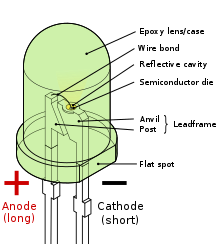Light-emitting diode(LED) is a semiconductor light source that emits light when current flows through it. Electrons in the semiconductor recombine with electron holes, releasing energy in the form of photons.
The color of the light (corresponding to the energy of the photons) is determined by the energy required for electrons to cross the band gap of the semiconductor. White light is obtained by using multiple semiconductors or a layer of light-emitting phosphor on the semiconductor device.
Appearing as practical electronic components in 1962, the earliest LEDs emitted low-intensity infrared (IR) light. Infrared LEDs are use in remote-control circuits, such as use with a wide variety of consumer electronics. The first visible-light LEDs are having low intensity and in limit to red. Modern LEDs are available in visible, ultraviolet (UV), and infrared wavelengths, with high, low, or intermediate light output.
What is the use of LED?
Visible LEDs are use in many electronic devices such as indicator lamps, in automobiles in rear-window and brake lights, and on billboards and signs as alphanumeric displays or even full-colour posters.
How do LED lights work?
An Light-emitting diode(LED) bulb produces light by passing the electric current through a semiconducting material—the diode—which then emits photons (light) through the principle of electroluminescence. Don’t let that big word scare you! It essentially means that a material (in this case, the diode) casts light when power is apply to it.
Is it LED or LED lights called?
An LED lamp or LED light bulb is an electric light that produces light using light-emitting diodes (LEDs). Commercial LED lamps have a lifespan many times longer than incandescent lamps.
Is LED a real word?
LED is the correct way to spell the past tense of lead. Lead is a common misspelling of the past tense of the verb lead.
What are the disadvantages of LEDs?
- High up-front costs.
- Transformer compatibility.
- Potential color shift over lamp life.
- Performance standardization has not yet been streamlined.
- Overheating can cause reduced lamp life.
What should be the biasing of LED?
The LED works when the p-n junction is forward biased i.e., the p- side is connected to the positive terminal and n-side to the negative terminal.
Why LED lights used for lighting nowadays?
Additionally, unlike Compact Fluorescent Lights (CFLs), LED lights do not contain mercury that can spill if dropped, making them a safer choice for household use. LEDs, which stand for Light Emitting Diodes, burn light 90 percent more efficiently than incandescent bulbs.
Why do LEDs fail?
When heat can’t dissipate from the heat sink, it can cause lamps to fail prematurely. Because LEDs emit light that decreases exponentially as a function of time and temperature. Adequate thermal management is key to making sure that LEDs will last in hot environments.
Do LED lights burn out?
Typically, LED bulbs can last between 35,000 and 50,000 hours. Furthermore, since LEDs do not contain a filament, they do not burn out in the same way as incandescent bulbs. In fact, LED bulbs rarely burn out at all. Instead, they dim with age.





